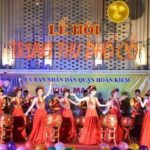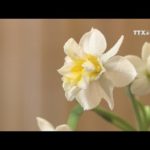Tet Han Thuc, or Cold Food Festival, is one of the four most significant traditional festivals of the year, per ancient Vietnamese beliefs. These festivals encompass Tet Holiday, usually held in late winter to bid farewell to the old year and welcome the Lunar New Year; Cold Food Festival, which marks the end of spring; Tet Doan Ngo or Insect Killing Festival, organized to welcome summer; and Mid-Autumn Festival, which celebrates when the moon is at its fullest and roundest.
| The exquisite offerings for the Cold Food Festival prepared by a skilled Hanoi housewife. |
Nowadays, it is customary for Vietnamese families to gather and cook traditional dishes to offer to their ancestors.
The Cold Food Festival typically takes place on the third day of the third lunar month, or April 11 this year. As is customary, Hanoians make two types of sweet dumplings – banh troi (floating dumplings) and banh chay (sweet mung bean dumplings) – to offer to their ancestors.
According to cultural researcher Tran Quang Duc, the ritual of consuming these dumplings during the Cold Food Festival in Vietnam dates back to the Le Trung Hung dynasty from 1533 to 1789.
The creations of skilled Vietnamese housewives also showcase the unique cultural characteristics of Vietnam, an agrarian nation closely tied to wet rice cultivation. Two types of dumplings, both made from delectable sticky rice flour, represent the arduous labor of farmers.
| Each of the Vietnamese cakes embodies a distinct meaning. |
“The banh troi has a round shape, evocative of the Vietnamese wish “Me tron con vuong” or a successful birth and good health for both mother and child. It also brings to mind the Vietnamese legend of Mother Au Co, who gave birth to an egg sac from which 100 children were born, the ancestors of the Bach Viet clans,” he explained.
“Meanwhile, banh chay is also made with glutinous flour (representing yin) and filled with mung bean paste (representing yang), illustrating the harmony of yin and yang according to Eastern philosophies. It is also a prayer of Vietnamese farmers for a year of favorable weather and bountiful harvests,” he added.
“Thus, the Vietnamese Cold Food Festival carries the significance of remembrance and gratitude for deceased ancestors,” he concluded.
In today’s fast-paced world, resourceful housewives need not prepare these dishes themselves, but can order them from online retailers or purchase them at the market. But as with many things, homemade is best. Many proficient Vietnamese cooks opt to make the cakes themselves.
| Traditionally, the banh troi and banh chay are white with a sugary taste, but talented cooks can make them more vibrant and flavorful by incorporating food coloring or flavoring into the dough |
| Transparent floating dumpling is one of the creations of Vietnamese housewives at this year’s Cold Food Festival |
| The Vietnamese-style dumplings and sticky rice in pink tone color |
| The eye-catching banh chay dumplings in the shape of animals delight the kids. |
They also come in an array of shapes and colors.
|
| The color of these dumplings is said to derive from natural ingredients. |
Exotic fruits much sought after for Tet holiday
With favourable natural conditions, the Mekong delta region is home to diverse fruit species. When Tet (Lunar New Year) comes, exotic fruits are offered for sales to serve people’s demand.

















